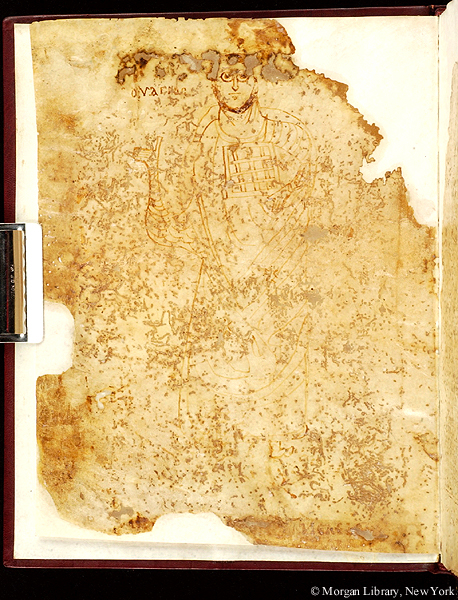
Manuscript of a homily on the Passion, attributed to St. Cyril of Jerusalem (St. Cyril, Bishop of Jerusalem); written and illuminated in Egypt, ca. 822/23-913/14.
Text: Homily II on the Passion.
Colophons: Plimpton 1, fol. 7v: Owner's name in Greek and Coptic: Property of the Monastery of Apa Epima of Psănte ("the acacia grove") at Narmoute (Narmouthis) in the Faiyum; for Ps̆ōnte (Psante) (Greek Akanthōn? "acacia"); 2) Plimpton 1, fol. 7v: Donation (?) or copyists (?) in Coptic: [...] memorializing [...] and Apiu or [...]apiu the priest and his son. (Since this text immediately follows colophon 1, it probably requests prayers for either the donors or the copyists (cf. Depuydt).
Written area ca. 274 x 191 mm. Divisions: Ekthesis, slightly enlarged initial, and paragraphus sign (painted budded diple, budded diple and obelus, or rarely coronis) setting off paragraphs..
Script: Upright (titles right-sloping). 10 lines = ca. 71 mm
Superlineation: Non-standard. Punctuation: Raised reddened dot in conjunction with a space; reddened colon and horizontal space filler at ends of paragraphs. Tremas.
Collation: No remains of signatures; no quire ornaments, monograms, headlines or catchwords.
Scribe: unknown; last letters of name may be apiu. Petersen (1954) suggests there are two copyists.
Decoration: frontispiece, headpiece, paragraphus signs, page numbers, extended letter. Colors: strong reddish orange (Centroid 25), green (chemically altered).
Related fragments: Five fragmentary leaves immediately following fol. 20 (completing the text block) are wanting and are now held at Columbia University as Plimpton 1.
